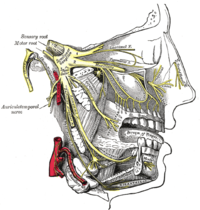
Photo from wikipedia
Importance Evidence regarding the nature and prevalence of 24-hour activity pattern phenotypes in older adults, especially those related to depression symptoms and cognition, is needed to guide the development of… Click to show full abstract
Importance Evidence regarding the nature and prevalence of 24-hour activity pattern phenotypes in older adults, especially those related to depression symptoms and cognition, is needed to guide the development of targeted mechanism research and behavioral interventions. Objectives To identify subgroups of older adults with similar 24-hour activity rhythm characteristics and characterize associated depression symptoms and cognitive performance. Design, Setting, and Participants From January to March 2022, a cross-sectional analysis of the 2011-2014 National Health and Nutrition Examination and Survey (NHANES) accelerometer study was conducted. The NHANES used a multistage probability sample that was designed to be representative of noninstitutionalized adults in the US. The main analysis included participants 65 years or older who had accelerometer and depression measures weighted to represent approximately 32 million older adults. Exposures Latent profile analysis identified subgroups with similar 24-hour activity pattern characteristics as measured using extended-cosine and nonparametric methods. Main Outcomes and Measures Covariate-adjusted sample-weighted regressions assessed associations of subgroup membership with (1) depression symptoms defined as 9-Item Patient Health Questionnaire (PHQ-9) scores of 10 or greater (PHQ-9) and (2) having at least psychometric mild cognitive impairment (p-MCI) defined as scoring less than 1 SD below the mean on a composite cognitive performance score. Results The actual clustering sample size was 1800 (weighted: mean [SD] age, 72.9 [7.3] years; 57% female participants). Clustering identified 4 subgroups: (1) 677 earlier rising/robust (37.6%), (2) 587 shorter active period/less modelable (32.6%), (3) 177 shorter active period/very weak (9.8%), and (4) 359 later settling/very weak (20.0%). The prevalence of a PHQ-9 score of 10 or greater differed significantly across groups (cluster 1, 3.5%; cluster 2, 4.7%; cluster 3, 7.5%; cluster 4, 9.0%; χ2 P = .004). The prevalence of having at least p-MCI differed significantly across groups (cluster 1, 7.2%; cluster 2, 12.0%; cluster 3, 21.0%; cluster 4, 18.0%; χ2 P < .001). Five of 9 depression symptoms differed significantly across subgroups. Conclusions and Relevance In this cross-sectional study, findings indicate that approximately 1 in 5 older adults in the US may be classified in a subgroup with weak activity patterns and later settling, and approximately 1 in 10 may be classified in a subgroup with weak patterns and shorter active duration. Future research is needed to investigate the biologic processes related to these behavioral phenotypes, including why earlier and robust activity patterns appear protective, and whether modifying disrupted patterns improves outcomes.
Journal Title: JAMA psychiatry
Year Published: 2022
Link to full text (if available)
Share on Social Media: Sign Up to like & get
recommendations!